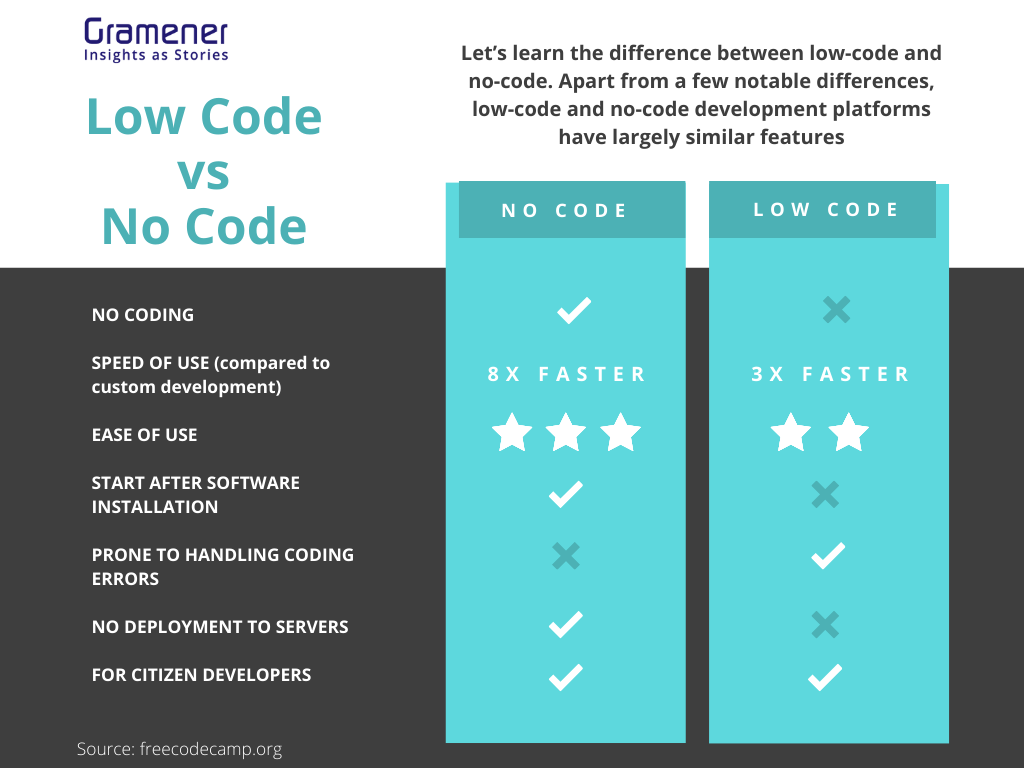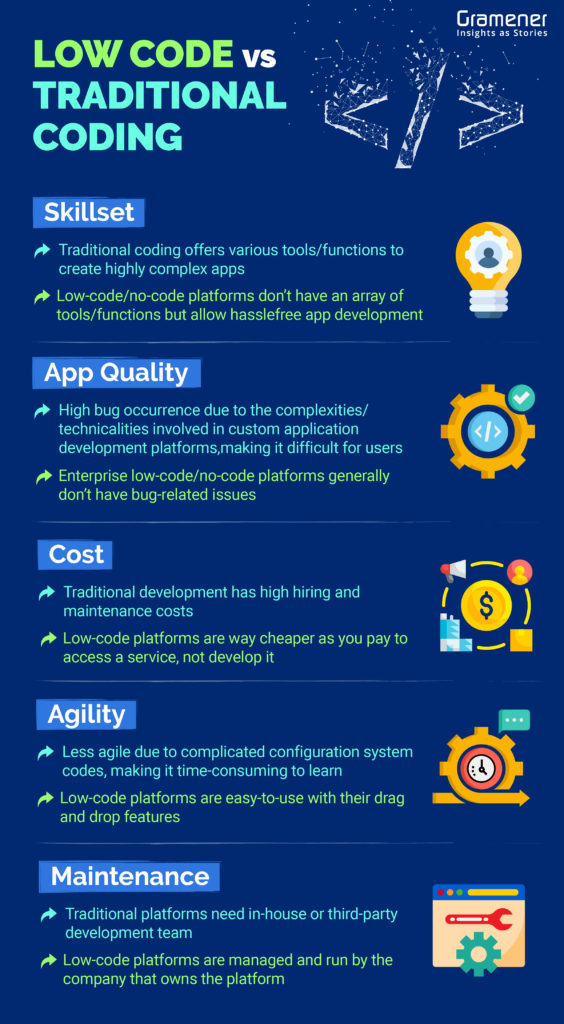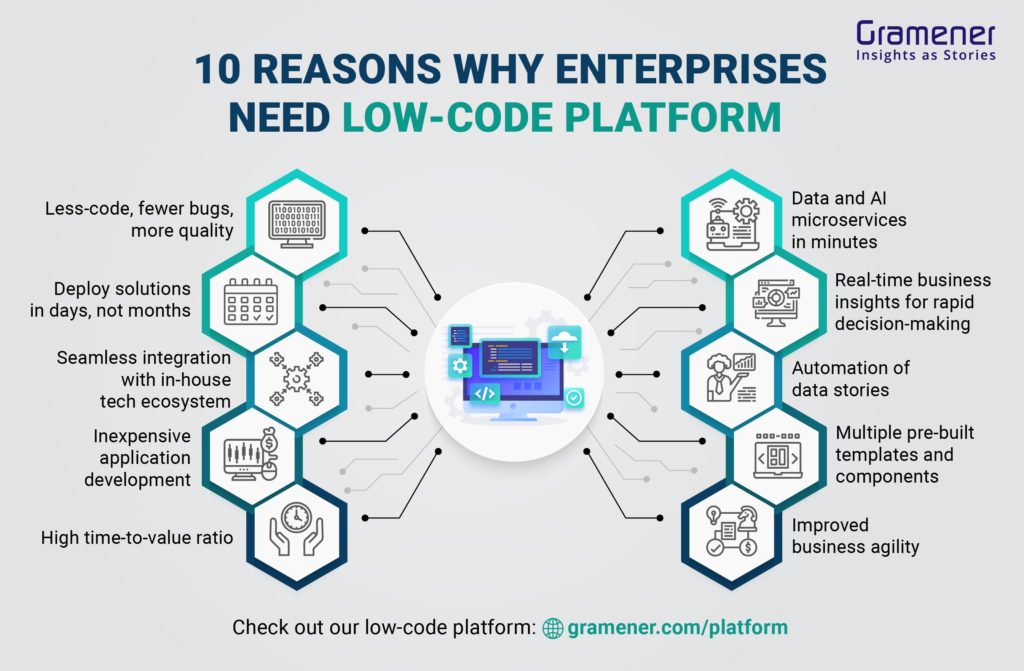When organizations think of the app development process in today’s scenario, often the first call they need to make is to have a significant decisive comparison of low-code vs traditional development method.
Whether you are a business leader or a person who knows software, you need to know this. There is always a need for customized software, and traditional software development cannot match your requirements. Traditional development methods take too much time and require a scarce and unique set of skills. This has been a problem for years. The need for digital transformation is critical.
This blog looks at what exactly a low-code development platform is and how it differs from the traditional coding process. So let’s take a look at low-code vs traditional development.
Find out the top 10 best low-code platforms in 2021
This rise was primarily due to Microsoft promoting PowerApps, Microsoft Flow, Power Platform products, and Power BI.
Gartner Predicts, by 2024 low-code application development will also be responsible for more than 65% of the application development activity.
In 2019, IT research firm Forrester reported that just over a third of developers said they used low-code platforms and products. Forrester predicted (pre-COVID-19) that the number would increase to over half of developers by mid-2020.
What is Low-code Development?
Software development can be done as much as broadly times faster than traditional methods with low-code development platforms.
The visual approach to software development is low-code/no-code. Low-code is a quicker, more inclusive, and more manageable approach to application development. With low-code, you can automate and abstract every step of the application cycle to simplify the delivery of an array of solutions.
Traditional development requires heavy coding, while low-code with drag and drop interface requires minimal coding to facilitate quicker development and delivery.
Thinking out-of-the-box from the traditional approach of business and IT (promoting continuous collaboration), your organization can develop answers that meet the requirements of your business.
With many advantages, the future of enterprise low-code development looks pretty bright. Enterprises should decide to shift to low-code development that has many benefits and features for efficient application development.
Now let’s learn the difference between low-code and no-code. Apart from a few notable differences, low-code and no-code development platforms have largely similar features.

When to Use Low-code Development?
Low-code development comes into action when the time to produce software is low. The pre-built components can assemble the software in a comparatively lesser time than a dedicated coding professional. The scarcity of low-code platforms in the market is one of the reasons why enterprises are still hesitant to adopt them. However, trying out the open-source model of a low code platform can help them understand the worth of this technology.
For Business Use Cases That Determine Agile Transformation
Low-code allows quick changes, and if these changes do not work, they can be easily rolled back. This cultivates agile transformations within a business. Thus business users from different departments can easily make changes in their apps for business transformation.
Low-code platform architecture reduces the time of the traditional development process taking more than six months for delivery to a couple of months only.
Rapid Production of Applications
In businesses, users from departments such as Marketing, HR, Operations, etc., wish to apply ideas to transform the way their department functions. Traditional development being less adaptive does not suit such ideas to constant changes. Moreover, to optimize its effectiveness, the speed-to-market for these internal transformations should be high, which is only possible with low-code.
Business users are always searching for new ideas and ways to seek innovation within their company. Still, they are unable to execute the same because of their helplessness to implement these innovative ideas. Hardcore coding knowledge is a must for traditional development, which only an IT professional has. Business users have to depend upon the IT staff, who are always occupied with their priority list of work and projects.
Low-code platform architecture requires very little or no coding experience to design new apps. With a simple user interface, business users can easily understand and develop their applications with nominal dependencies on the IT staff. Hence there is faster development and deployment of the app.
Low-code plays a vital role in improving the overall growth of your business when you compare Low-code vs. traditional development. The cost and time-saving benefits of low-code can save your company $50-$100K of your application development cost!
Developing Customized and Unique Apps
Every business has its unique requirements that need customizable solutions. Traditional development is costly, time-consuming, and requires a specific skill-set for development. Hence it is not a desirable scenario for most companies/organizations.
Low-code helps businesses with the correct tools for application development. It improves overall efficiency, overall morale, and productivity within an organization.
Low-Code/No-Code vs Traditional Coding – Which is Better?
As explained above low-code/no-code supports business users, developers, and citizen developers to quickly build the apps using drag-and-drop interfaces. Here are some of the key differences between low-code/no-code and traditional coding.

Required skill-sets for developing apps
Traditional coding brings with itself a variety of tools and multiple functions that supports developers to develop highly complex apps. For operating such applications correctly, one needs highly sophisticated and technical know-how in this domain.
On the other hand, the low-code/no-code platform doesn’t feature an array of tools and functions. But these platforms without any hassle help in developing various kinds of apps. With a no-code/low-code approach, it is easier to develop apps without mastery in required skill-sets in this domain.
Agility
Due to the complicated configuration system of the traditional development platforms, they are less agile. Also, the complex code requires a lot more time and skill-sets to operate.
While the low-code platforms are easy to operate due to drag and drop features. And unlike custom development, there is no need to write codes for developing the applications. You can just use the drawing methods for the same.
App Quality
A lot of bugs occur due to the complex nature and high technicalities of the custom application development platforms, making it difficult for the users. Whereas, the probability of getting bugs in the development phase is trivial with enterprise low-code/no-code platforms. This helps in the development of hassle-free apps and the smooth running of the system.
Development Cost
When you think of low-code vs custom code, the custom-made or traditional software is very expensive to design and build. Depending upon the requirements of the project the cost may vary but still, it would be notably high.
While the no-code/low-code platform is affordable as the company has to only pay for a specified access service and not for its development from start to end.
Maintenance
Maintenance is a big issue with traditional development as even if there are minor revisions it would need a third-party development team or dedicated in-house developers to apply the changes. Also, software revision too is a huge task and requires proper designing, planning, execution, and testing followed by bug fixing.
Being PaaS (Platform as a service), the low-code platforms are managed and run by the company that owns the platform. Hence all the host company, and not the business contributing to the service, takes care of all the software improvements and updates. The companies earn benefits as they don’t need to pay for the in-house team or a third-party vendor and still the software is well-maintained.
Key Features of Low-Code/No-Code Platforms
Now let’s glance through the following features and key ingredients of the low-code/no-code platform.
Visual Modeling
The complex code of traditional development is replaced by a drag-and-drop interface of low-code/no-code platforms. This helps in managing and processing of data via visual modeling.
Cross-Platform Accessibility
One of the most important features of low-code/no-code platforms is multi-device compatibility. Cross-platform compatibility helps users to use the low-code platform on any device with major operating systems and developing apps that can run on all devices, and core platforms.
Robust Functionality
Out-of-the-box functionality that eliminates the requirement to develop core modules from scratch for apps is possible with notable low-code systems. Core modules like data management, customer service management, etc. in some of the platforms are pre-built.
Reusability
The functionality for apps and usage of pre-configured modules is another important aspect of low-code development. These pre-configured modules come with all the general core functions required for different apps and can be deployed quickly for multiple solutions.
Reporting and Monitoring
When an app is built using low-code platform architecture it can monitor processes and workflows to keep track of its efficiency. For analytical purposes to they are very useful and can also to keep-an-eye on the performance of other apps.
You can develop three major types of applications on a low-code/no-code platform:
- Mobile Applications: Customized mobile applications for tablets and smartphones. Low-code/no-code platform is an important reason for the rapid rise in mobile app development.
- Web Applications and Portals: Low-code/no-code platforms are highly preferred for web application development without coding. You can bridge the gap between your back and front office with such applications.
- Back Office Applications: These applications allow you to administer your business data for internal use via back-office module only.
Low-code Platform Use Cases vs Traditional development

Microservices-Based Applications
Enterprises like Netflix, Amazon, Flipkart, etc. with the help of low-code development can create several micro apps that can incorporate with each other. From a monolithic approach, these businesses are now moving to microservices. This is because instead of scaling the complete monolithic system, micro-services allows organizations to autonomously scale required services
Minimum Viable Products
There is no meaning to plunge into a traditional coding approach with a long development process just to check your business idea. Rather you can build an MVP (minimum viable products) to demonstrate your knowledge and assure investors or to challenge it with nominal losses.
Omni-Channel Incorporations of Standardized Solutions
Mostly financial institutions, banks, and insurance companies use Low-code platforms to develop omni-channel payment solutions. In fact, Low-code platforms accelerate the development and inauguration of software to rapidly fetch data from numerous data sources, process it, and exhibit it on mobile and web dashboards.
Simple Employee Or Partner-Facing Apps
Paper-based processes can be automated to improve the workflow via low-code platforms thereby benefiting the business owners. By incorporating core internal systems, cross-departmental operations are supported by these apps.
Conclusion
The Future of low-code development seems to be very bright as more and more companies are integrating them with their app expansion lifecycle.
Today more and more software development companies are augmenting the traditional approach with low-code/no-code development. Thus with a limited task force, one can still boost productivity. Low-code/no-code platforms allow businesses to escape developer skill shortages and divert the challenge to lessen the time to market and optimize ROI.
Lastly, the ongoing discussion on low-code vs traditional development is real. It should not be looked upon as either/or result. Rather both these contrasting approaches present a bright opportunity with respect to driving innovation and speed.
Contact us to know how our low code development platform can help you build data and AI apps rapidly.

